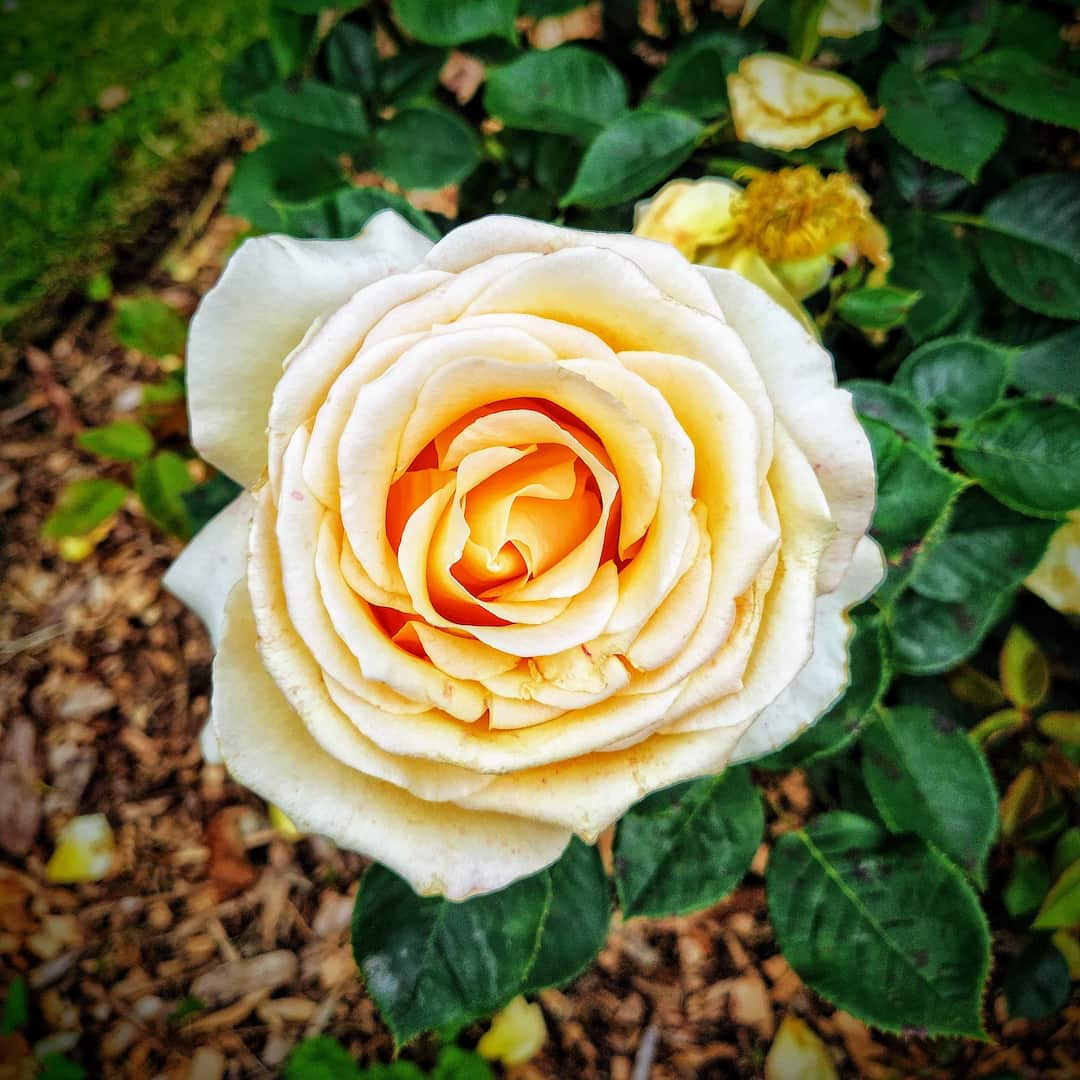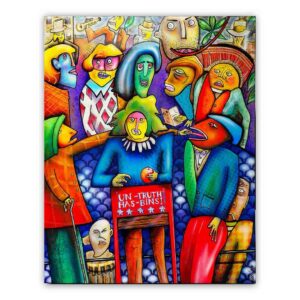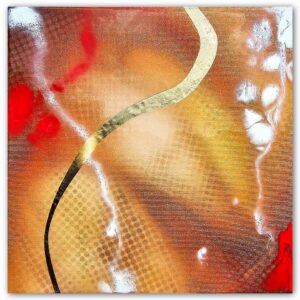- [email protected]
- +353 (0)86 224 0139
- Free Shipping Worldwide
Paintings of Flowers: Beauty That Transcends Time
In this article, we will explore the rich history, techniques, and significance of flower paintings. We will also discover how these mesmerizing pieces have influenced and shaped the art world.
Reading Time: 20 minutes
TL:DR
- Explore the beauty, techniques, and symbolism of famous flower paintings by renowned artists.
- Discover the diverse styles and approaches used by artists to depict flowers, from Impressionism to abstraction.
- Gain insights into the historical and cultural contexts that influenced artists throughout the centuries in their portrayal of flowers.
Introduction: Immerse Yourself in the Timeless Beauty of Nature
For centuries, flowers have captivated artists and viewers with their beauty. In art, flowers have been used to symbolise religious and spiritual themes, as well as the beauty of and role of flowers in our natural world.
The meaning of flowers in art can be assigned to different emotions for different blooms, such as love, purity, or sorrow.
In this blog post, we will explore the enchanting world of floral art and explore the timeless beauty and appeal of paintings of flowers in modern times.
Why Are Flower Paintings So Popular?
Flowers are a universal symbol of beauty and hope. They also serve as a reminder of the fleeting nature of life, which may make them even more precious.
Floral art can be appreciated by people of all ages and backgrounds. They can also add a touch of sophistication and elegance to any room.
Historical Significance of Floral Art
Floral art has a rich historical significance that dates back to ancient civilizations. In ancient Egypt, flowers were depicted in murals and tombs, symbolizing the cycle of life and death. In ancient Greece and Rome, floral motifs adorned pottery, mosaics, and sculptures, adding a touch of natural beauty to everyday life.
During the Renaissance period, flowers became a popular subject in religious and mythological paintings. Artists such as Botticelli and Raphael incorporated flowers into their works to convey messages of love, purity, and divinity. The intricate details and vibrant colours of these paintings showcased the technical skill and artistic prowess of the Renaissance masters.
In the 17th century, the Dutch Golden Age saw the emergence of still-life paintings featuring flowers. Artists like Jan van Huysum and Rachel Ruysch meticulously depicted bouquets of flowers with remarkable accuracy and attention to detail. These paintings not only celebrated the beauty of nature but also served as status symbols. By showcasing the wealth and refinement of the patrons who commissioned them, they demonstrate some of the cultural influences on floral art.
Floral art has continued to evolve throughout history, reflecting the changing styles and tastes of each era. In the 19th century, Impressionist artists such as Monet and Renoir captured the fleeting beauty of flowers in their open-air paintings.
Today, floral art continues to thrive in a variety of mediums. From traditional oil paintings to contemporary digital art, artists are still drawn to the beauty and symbolism of flowers.
Floral Art: A Connection to Nature and Serenity
Floral paintings connect us to nature, even in urban settings. They bring the beauty of the natural world into our living spaces, creating a sense of serenity and tranquility.
A bouquet of flowers in a vase or a landscape painting featuring blooming fields can transport us to a peaceful and harmonious realm. Floral art can enhance the beauty and serenity of interior spaces.
A well-chosen floral painting can serve as a focal point, adding a touch of colour and vibrancy to a room. It can create a soothing atmosphere and evoke a sense of calmness.
Floral art is often used in interior design to create an inviting and tranquil environment. It also has therapeutic and calming effects. Studies have shown that exposure to nature and natural elements, such as flowers, can reduce stress and anxiety.
Emotional Impact of Floral Art
Floral paintings have a powerful emotional impact on viewers, evoking a wide range of feelings and emotions. Their timeless beauty transcends cultural and generational boundaries.
Many people find solace and comfort in floral art. Its vibrant colours, delicate details, and serene compositions can uplift spirits, evoke joy and hope, and provide inspiration.
Floral paintings can also evoke nostalgia and longing. They remind us of the fleeting nature of life and the beauty that exists in every moment. Like life itself, flowers are transient and ephemeral, and paintings of flowers capture these fleeting moments, allowing us to pause and appreciate the beauty that surrounds us.
Understanding the Symbolism and Interpretation of Flowers
Flowers have long been associated with symbolism and interpreted to convey various meanings in art. Different types of flowers carry different symbolic significance.
Roses: Symbol of Love and Beauty
Roses, with their delicate petals and brilliant hues, are often associated with love and passion. In traditional art, roses can evoke feelings of passion and beauty, reflecting the intensity of love or serving as a metaphor for the fleeting aspect of life.
Personal Experience
In recent years, the presence of the lovely Rose Garden in St. Anne’s Park on my doorstep has subconsciously motivated me to plant a few roses in my garden.
I’ve learned to appreciate the variety of colours, scents, and beauty; they always remind me of both my grandmothers.
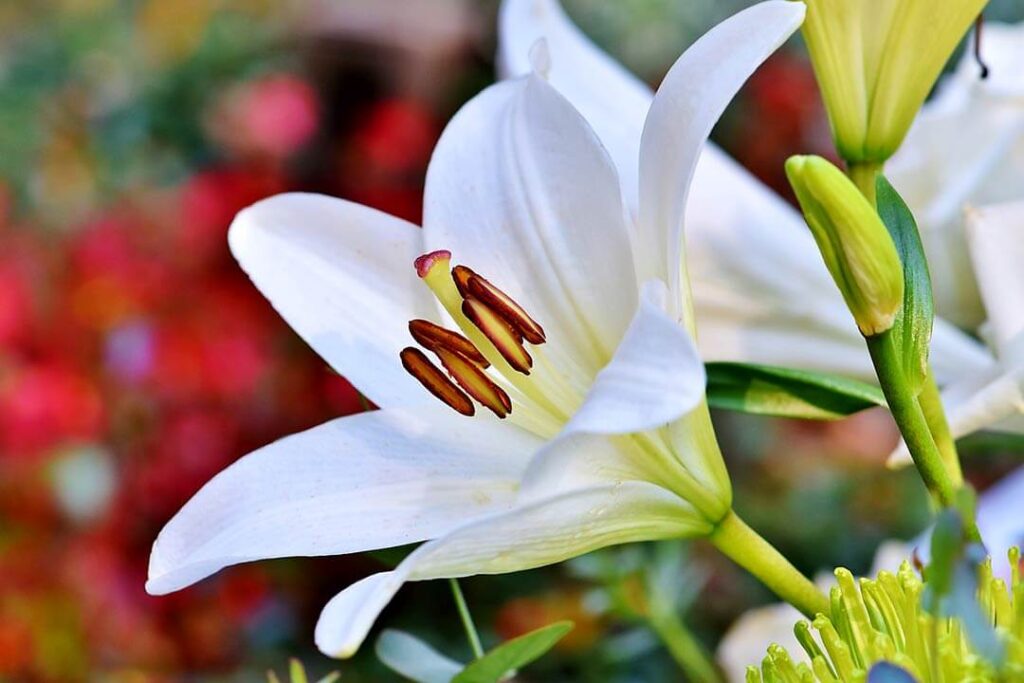
Lilies: Symbol of Purity and Holiness
Lilies hold a more spiritual connotation in traditional art. These elegant flowers are often depicted in religious paintings, symbolizing purity, innocence, and the divine.
Religious Symbolism
Artists use lilies in floral art to represent religious symbolism. Lilies convey spirituality and holiness in their artwork.
Sunflowers: Symbol of Vitality and Happiness
Sunflowers are often seen as a symbol of vitality and happiness. Their vibrant yellow colour and towering height evoke a sense of energy and life.
In traditional art, sunflowers can represent loyalty, adoration, and longevity. Artists use sunflowers to portray the joy and optimism that these flowers embody. Vincent van Gogh’s famous sunflower series is a prime example of this.

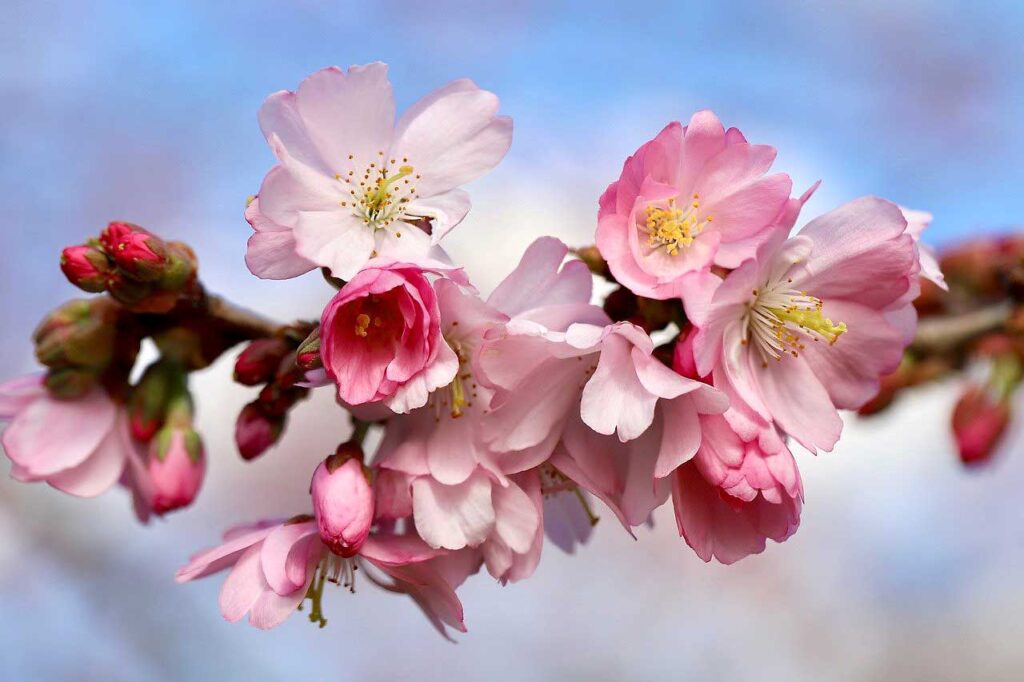
Cherry Blossoms: Symbol of Ephemeral Beauty
Symbolism
Cherry blossoms symbolize the transient nature of life, as they bloom only for a short period each year. They often represent beauty, renewal, and the ephemeral nature of existence.
Artists use cherry blossoms to capture the beauty of spring and to reflect upon the fleeting nature of life.

Lotus Flowers: Symbol of Purity and Enlightenment
Lotus flowers hold immense symbolic meaning in many cultures, especially in Buddhism, Hinduism, Jainism and Sikhism. They are often associated with purity, enlightenment, and spiritual awakening.
In art, lotus flowers are depicted as emerging from muddy waters, symbolizing the journey from darkness to light. Artists use lotus flowers to convey a sense of inner peace and serenity.
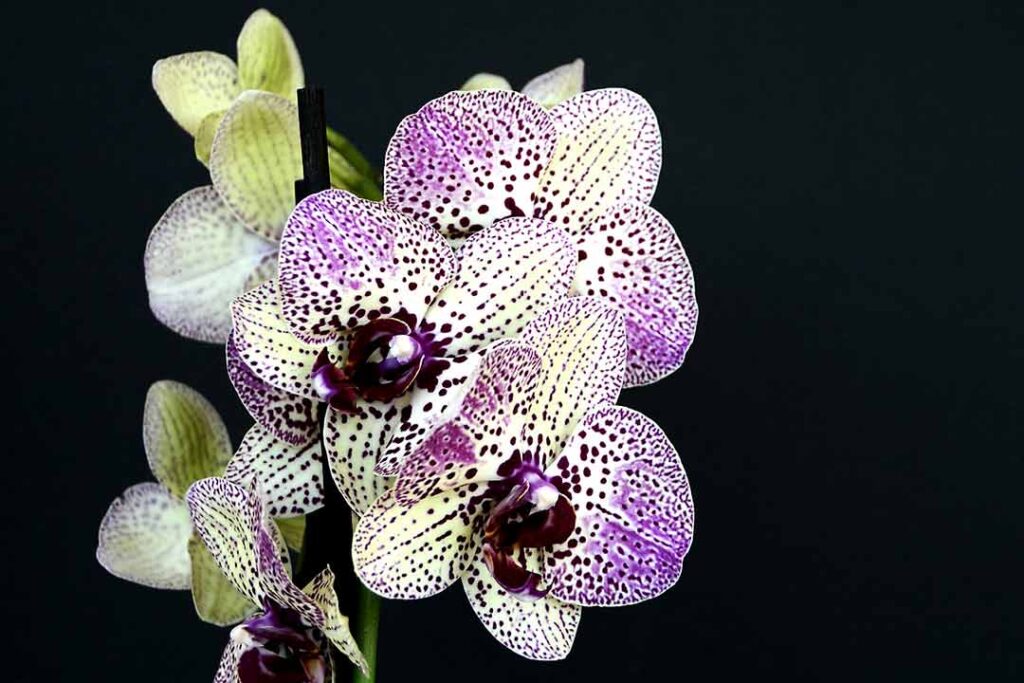
Orchids: Symbol of Elegance and Grace
Orchids stand out as symbols of elegance and grace. Their exquisite blooms have inspired artists and painters throughout history, and they carry profound symbolism and interpretation.
Orchids as Muse
Orchids have been a muse for countless painters who sought to capture their delicate allure on canvas. The intricate details of each petal, the vibrant hues that range from soft pastels to bold and vibrant shades, all contribute to the visual poetry that is an orchid. Artists use these flowers as symbols to convey various emotions and concepts, such as love, beauty, femininity, or even exoticism.
Symbolism of Orchids
Beyond the realm of aesthetics, and often being classed as, exotic flowers for enthusiasts, lies the deeper symbolism associated with orchids. Each species carries its own unique meaning. For instance, the Phalaenopsis orchid symbolizes innocence and purity while the Cattleya represents love and passion. Understanding these symbolic meanings allows us to appreciate not only their physical beauty but also delve into their hidden messages.
Interpreting the Symbolism
Interpreting the symbolism of flowers like orchids can be a deeply personal experience. It allows us to connect with nature on a spiritual level and find meaning in our surroundings. Whether it’s gifting someone an orchid arrangement or incorporating them into our daily lives through art or decor, we can embrace these symbols as reminders of love, beauty, strength, or whatever significance they hold for us individually.
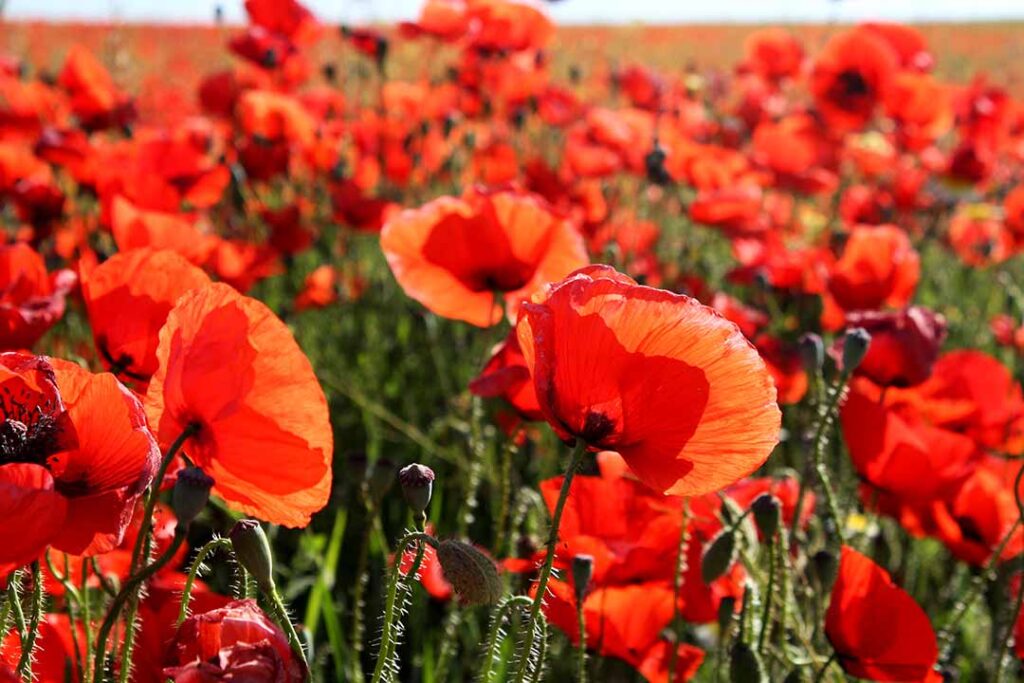
Poppies: A Symbol of Remembrance, Sacrifice, and Complexity
Poppies have long been a powerful symbol in art and literature. Their vibrant hues and delicate petals have captivated artists and writers for centuries.
Symbolism of Poppies
- Remembrance and sacrifice: In British culture, the red poppy has become synonymous with honoring fallen soldiers.
- Opium cultivation: Afghanistan used to produce more than 80% of the world’s opium, but after the US withdrawal in 2021, the Taliban imposed a ban on poppy cultivation.
- Personal interpretation: Sylvia Plath’s poem “Poppies in July” explores her personal interpretation of these flowers.
Appreciating the Deeper Layers
Understanding the symbolism and interpretation of flowers like poppies allows us to appreciate not only their aesthetic appeal but also the deeper layers they hold within our collective consciousness. It reminds us of the complex relationship between nature and human actions.
Timeless Beauty: Different Styles of Floral Paintings
Despite changing art trends, paintings of flowers continue to possess a timeless beauty that captivates audiences. The delicate and intricate details of flowers can be captured in paint, creating a sense of timelessness. Artists employ various techniques and styles to immortalize the beauty of flowers on canvas.
Impressionist Flower Paintings
Impressionist flower paintings are a captivating and timeless subject. Artists like Monet, Renoir, and van Gogh used loose brushstrokes and vibrant colours to capture the essence and vibrancy of flowers.
Capture the Essence of Flowers
Impressionist artists painted flowers ‘en plein air’, directly in nature, to capture the ever-changing light and natural environment. They depicted flowers in various stages of bloom, capturing their fragile beauty and ephemeral nature in the open air, especially the in either morning or evening daylight of outdoors.
What Are The Best Colours For ‘En Plein Air’ Painting?
The art of plein air painting is a beloved tradition that has captivated artists for centuries. The ability to capture the beauty of nature in its raw form is an incredible skill, and one that many artists strive to master. When it comes to painting flowers en plein air, there are certain colours that work best to convey their timeless beauty.
Vibrant and full of life, flowers are a stunning subject for plein air painting. To truly capture their essence, it is important to choose colours that are bold and expressive. Some of the best colours to use on you palette for painting flowers include:
- Cadmium yellow light is a warm, sunny colour that can beautifully depict the petals of a sunflower or a daisy.
- Cadmium orange, on the other hand, adds a touch of warmth and depth to the painting, making it perfect for capturing the vibrant hues of a poppy or a marigold.
- Cadmium red medium is a rich, intense colour that can be used to paint roses or tulips, adding a sense of drama and passion to the artwork.
- Dioxazine purple is a deep, dark colour that can be used to create shadows and add depth to the painting. It is particularly effective when painting flowers with darker tones, such as violets or pansies.
- Ultramarine blue, on the other hand, is a cool, calming colour that can beautifully depict the delicate petals of a forget-me-not or a hydrangea.
- Lastly, phthalo green is a bright, vibrant colour that can be used to paint the leaves and stems of the flowers. It adds a sense of freshness and vitality to the painting, making the flowers come alive on the canvas.
When painting flowers en plein air, it is important to pay attention to the details. Using a variety of brushes to create texture and depth will help bring your painting to life. Experiment with different brush strokes and techniques to capture the intricate details of the petals and leaves.
Adding highlights and shadows can also help create a sense of depth and dimension in your painting. This can be done by using lighter and darker shades of the same colour. For example, if you are painting a red rose, you can use a lighter shade of red to add highlights to the petals, and a darker shade of red to create shadows. You can learn more about the colour red in this article.
Characteristics of Impressionist Flower Paintings
Emphasis on light and colour is a defining characteristic of impressionist flower paintings. Artists used vibrant, bold colours and loose brushstrokes to create a sense of movement and atmosphere.
Interplay between light and shadow is another important characteristic of impressionist flower paintings. By capturing the play of sunlight on petals or the dappled shade beneath a tree, artists were able to create depth and dimension in their paintings.
Impact of Impressionist Flower Paintings
Impressionist flower paintings have a unique ability to evoke emotions and transport viewers to another time and place. They allow us to appreciate the simple beauty of nature and remind us of the fleeting moments that make life so precious.
Realistic Flower Paintings: Capturing the Essence of Nature
Realistic flower paintings capture the stunning details and evoke tranquility and elegance. Artists recreate the intricate patterns and textures of nature with meticulous attention to detail and lifelike representation.
Characteristics of Realistic Flower Paintings
Artists often depict flowers in their natural habitats, adding depth and context to the painting.
Realist artists focus on capturing the intricate details of petals, leaves, and other botanical features. These paintings showcase the technical skill and patience of the artist, allowing viewers to appreciate the beauty of flowers in a hyper-realistic manner.
The Flemish technique, a traditional oil painting technique, adds depth and luminosity to flower paintings. It involves building up layers of transparent glazes to create a realistic depiction of light and shadow.
Artists who use the Flemish technique carefully observe the basic geometric shapes of blossoms and adhere to the rules of depicting form within each flower, resulting in captivating and lifelike representations of flowers.
The vibrant colours and delicate details brighten up a room, adding a touch of elegance and sophistication to any décor.
The Timeless Appeal of Realistic Flower Paintings
Realistic flower paintings have a universal appeal that transcends time and cultural boundaries. They remind us to slow down, appreciate the beauty of nature, and find joy in the simple pleasures of life.
In a world where technology dominates our lives, realistic flower paintings offer a respite from the digital realm. These paintings can serve as a source of inspiration, encouraging us to stop and smell the roses, so to speak, and find joy in the simple pleasures of life.
Surrealist Flower Paintings: A Fascinating Genre of Art
Surrealist flower paintings are a unique and captivating genre of art that merges reality with the fantastical. These artworks transport viewers into a dreamlike realm, where flowers take on new meaning and captivate us with their vibrant colours and unexpected forms.
Characteristics of Surrealist Flower Paintings
One of the defining characteristics of surrealist flower paintings is the use of vibrant and intense colours. These hues evoke strong emotions and create a sense of heightened reality. Flowers are often depicted in exaggerated and distorted forms, challenging our perception of their natural beauty. Petals may morph into abstract shapes, stems may twist and turn unexpectedly, and the overall composition may defy gravity.
The juxtaposition of ordinary objects with flowers is another hallmark of surrealist flower paintings. Artists often incorporate unexpected elements such as clocks, mirrors, or even human figures into the compositions. These juxtapositions invite viewers to question the boundaries between reality and the subconscious, blurring the line between the familiar and the strange.
The Timeless Beauty and Symbolism of Surrealist Flower Paintings
Surrealist flower paintings also often convey a sense of mystery and symbolism. Flowers have long been associated with various meanings and emotions, and surrealist artists leverage these associations to add depth to their works. A single flower may represent love, while a bouquet may symbolize abundance or fertility. By infusing these symbols into their paintings, artists invite viewers to interpret the artwork in their own unique way.
Surrealist flower paintings continue to enchant art enthusiasts around the world with their timeless beauty and captivating imagery. These artworks challenge our perception of reality and invite us to explore the depths of our subconscious minds. Whether displayed in a gallery, hanging on the walls of a home, or adorning the pages of a book, surrealist flower paintings are sure to ignite the imagination and inspire the soul.
Abstract Flower Paintings: A Stunning and Captivating Form of Art
Abstract flower paintings are a beautiful and unique way to add a touch of elegance and vibrancy to any space. These paintings use bold colours, imaginative brushstrokes, and compositional techniques, such as negative space, to capture the essence of flowers in a creative and expressive way.
The Beauty and Creativity of Abstract Flower Paintings
Artists experiment with different techniques and styles to create abstract flower paintings, resulting in a wide range of interpretations. Some artists use bold and expressive brushwork, while others create delicate and intricate details. Each painting is a one-of-a-kind masterpiece that reflects the artist’s unique vision.
The Versatility and Adaptability of Abstract Flower Paintings
Abstract flower paintings are versatile and adaptable to any environment. Whether you’re looking to add a pop of colour to a minimalist space or create a focal point in a more traditional setting, these paintings can effortlessly transform the ambiance of any room.
The Emotional Power of Abstract Flower Paintings
Abstract flower paintings can evoke emotions and feelings in the viewer. The use of bold and contrasting colours can elicit a sense of joy, excitement, or even tranquility, depending on the artist’s intention. These paintings can also serve as a visual representation of the beauty and fragility of nature, reminding us of the fleeting yet awe-inspiring moments that flowers bring to our lives.
If you’re looking for a way to add a touch of elegance, vibrancy, and emotion to your space, consider investing in an abstract flower painting. These artworks are sure to captivate and inspire all who view them.
Victorian Botanical Paintings: Capturing the Timeless Beauty of Flowers
Flowers have captivated artists throughout history. Victorian botanical paintings combine scientific accuracy with artistic expression to capture the essence of flowers. Artists meticulously studied each plant, paying close attention to its structure, colour, and texture.
Victorian botanical paintings, or rather illustrations, are revered for their ability to capture the true essence of flowers. These paintings served multiple purposes, including education, exploration, and discovery. Today, Victorian botanical paintings continue to captivate audiences with their timeless beauty.
Characteristics of Victorian Botanical Paintings
Victorian botanical paintings are characterized by their exquisite detail and precision. Artists used watercolour or oil paints to recreate the vibrant hues and subtle nuances of petals, leaves, and stems. The paintings often depicted detailed information about the plants and their properties, making them valuable resources for scientists and botanists.
The Significance of Victorian Botanical Paintings
Victorian botanical illustration played a significant role in the exploration and discovery of new plant species. As explorers ventured into uncharted territories, they encountered unfamiliar flora. Botanical illustrations helped catalog and document these newfound plants, contributing to the expanding knowledge of the natural world. Additionally, they also influenced Victorian era floral design.
Victorian Botanical Paintings Today
Today, Victorian botanical paintings continue to captivate audiences with their timeless beauty. They are displayed in galleries, museums, and private homes, reminding us of the delicate intricacies and ephemeral nature of flowers. These paintings stand as a testament to the enduring allure of flowers and the remarkable skill of the artists who sought to capture their beauty.
Victorian botanical paintings are a unique and captivating art form that celebrates the beauty of nature. They are a testament to the skill and dedication of the artists who created them, as well as the enduring allure of flowers. Whether you are an art enthusiast, a nature lover, or simply someone who appreciates beauty, Victorian botanical paintings are sure to captivate and inspire you.
Exploring the Work of Iconic Artists: Beautiful Paintings of Flowers
Renowned artists throughout history have dedicated their talent to capturing the essence of flowers in timeless masterpieces.
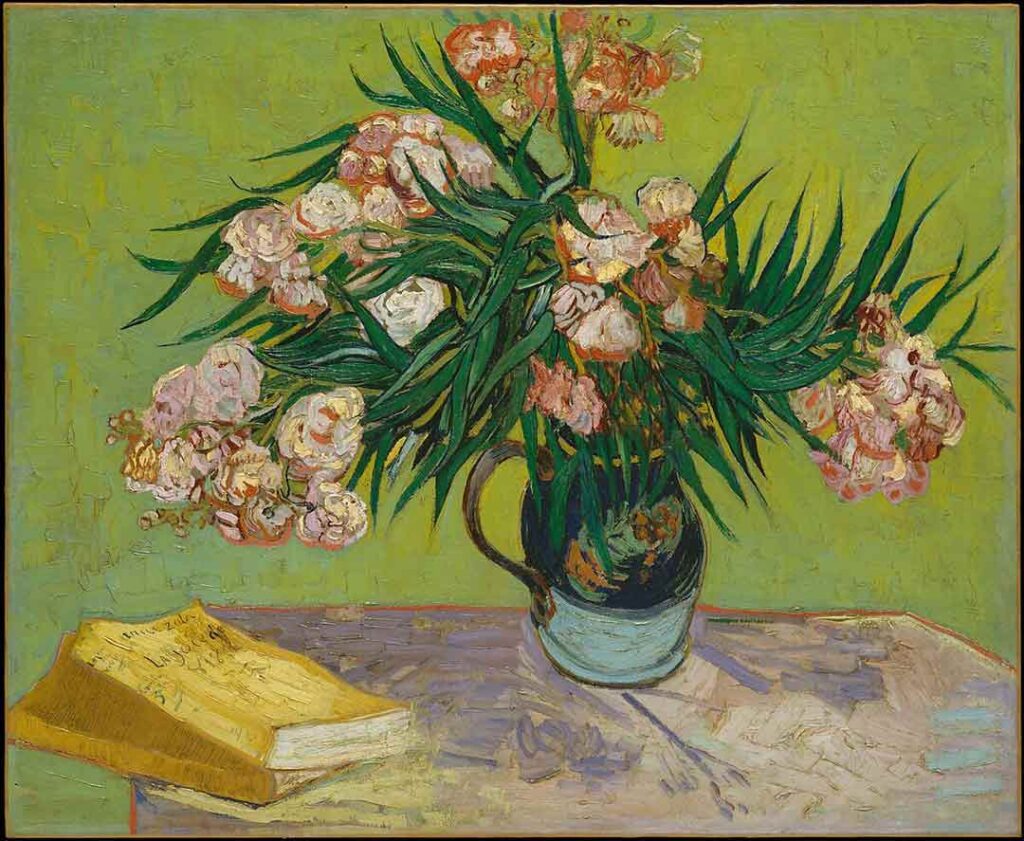
Vincent van Gogh: The Dutch post-impressionist painter is perhaps one of the most well-known artists for his flower paintings.
His vibrant and expressive brushstrokes bring flowers to life, showcasing his deep admiration for the natural world.
His “Sunflowers” series and “Irises” are iconic examples of his mastery in capturing the essence and beauty of flowers.

Gustav Klimt: The Austrian symbolist painter infused his floral subjects with sensuality and allure in his painting “Bauerngarten.”
This painting portrays a lush garden filled with an abundance of colourful flowers, creating a mesmerizing tapestry of nature’s beauty.
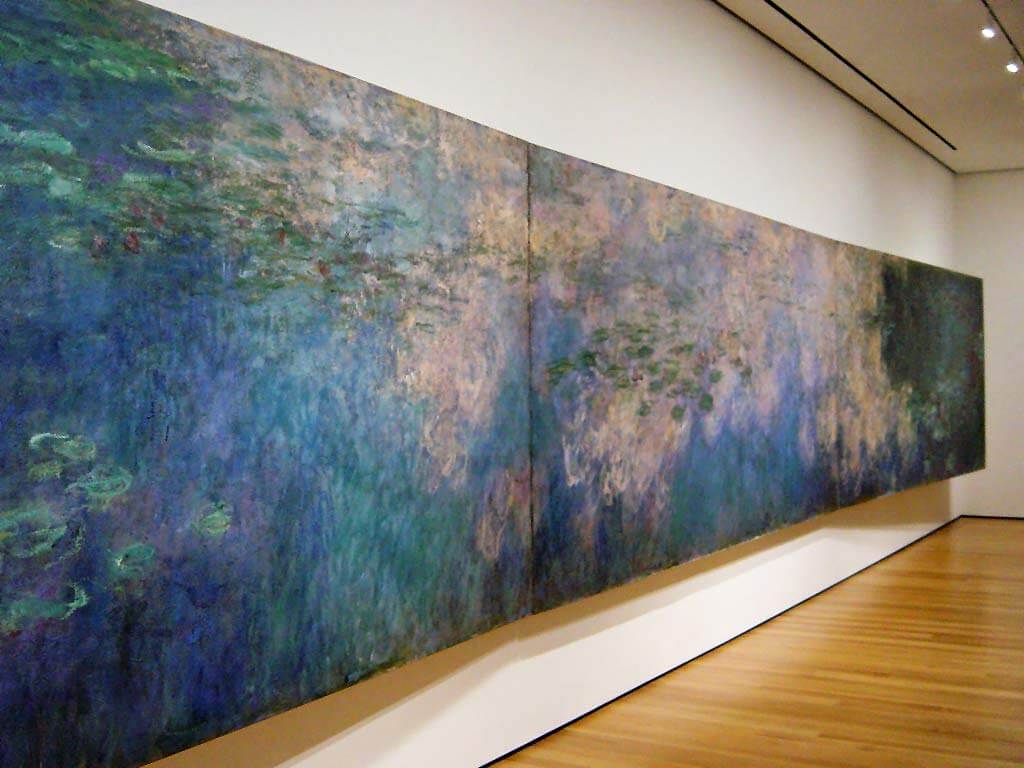
Claude Monet: The French painters water lily paintings are some of his most recognizable and celebrated works.
Monet was inspired by the famed water lily pond to produce a massive work comprised of around 300 paintings, about 40 of which were large scale.
These paintings capture the beauty of water lilies and their reflections in the water, creating a sense of peace and calm.
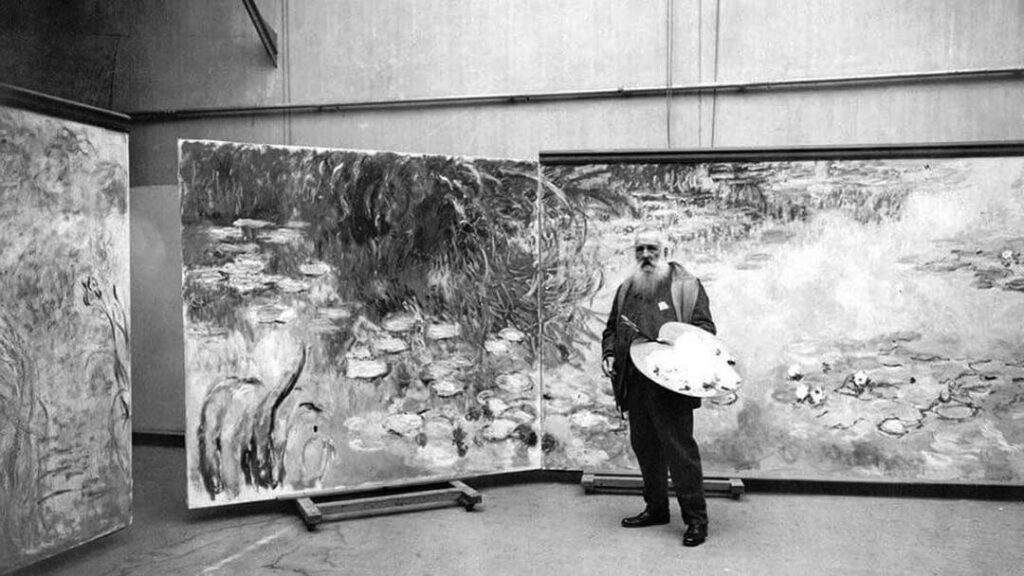
The Influence of Flowers on Decorative Arts
Flowers have long inspired artists and designers in decorative arts, shaping various art forms, including painting, sculpture, and textiles.
Artists are fascinated by the meaning of flowers. Each flower has a unique meaning, allowing artists to express emotions and messages in their work. Flowers are powerful visual metaphors in decorative arts, representing romance (roses) or purity (lilies).
Rococo Floral Paintings
The Rococo period of the 18th century was a time of artistic extravagance and opulence. The Rococo art movement is known for its ornate and highly decorative nature, as well as its grandeur and attention to detail. One of the most popular motifs in Rococo art is paintings of flowers, which were often used to adorn walls and furniture. These paintings are a testament to the timeless beauty and appeal of floral art.
Characteristics of Rococo Floral Paintings
Rococo floral paintings are vibrant and full of life. They capture the essence of nature’s bounty, showcasing a variety of flowers, such as roses, lilies, tulips, and daisies. The artists of this period excelled at capturing the delicate petals, intricate patterns, and vivid colours of these blossoms. Their attention to detail is evident in every stroke of the brush, creating a feast for the eyes.
Prominent Rococo Floral Painters
Prominent Rococo floral painters include Jean-Honoré Fragonard, François Boucher, and Jean-Antoine Watteau.
- Fragonard’s works often depicted lush gardens filled with an abundance of flowers, as seen in his painting “The Swing.”
- Boucher’s work often showcased bouquets of flowers, arranged in intricate compositions that exuded elegance and sophistication.
- Watteau, known for his contribution to the Rococo movement, also produced beautiful paintings of flowers. His artwork often featured delicate and intricate still-life arrangements, where each flower was meticulously rendered.
These paintings captured the fleeting beauty of flowers, emphasizing their fragility and transience.
The Appeal of Rococo Floral Paintings
The appeal of Rococo floral paintings extends beyond the 18th century. Even today, these artworks continue to captivate viewers with their timeless beauty. They are a popular choice for home décor, as they add a touch of colour and elegance to any room. Hanging a Rococo floral painting on your wall can instantly transform the space, creating a serene and relaxing atmosphere.
Tips for Incorporating Rococo Floral Paintings into Your Home Décor
Here are some tips for incorporating Rococo floral paintings into your home décor:
- Hang a large Rococo floral painting above your fireplace or sofa to create a focal point in your living room.
- Group several smaller Rococo floral paintings together on a gallery wall to create a stunning display.
- Place a Rococo floral painting on a nightstand or dresser in your bedroom to add a touch of elegance and romance.
- Hang a Rococo floral painting in your bathroom to create a serene and spa-like atmosphere.
- Use Rococo floral paintings as inspiration for your home décor colours and patterns.
No matter how you choose to incorporate them into your home décor, Rococo floral paintings are sure to add a touch of beauty and sophistication to any space.
The Arts and Crafts Movement and Its Influence on Floral Art
Flowers became a central motif in design during the Arts and Crafts Movement in the late 19th century. This movement celebrated craftsmanship and rejected mass production, emphasizing the beauty of nature-inspired patterns and motifs. Flowers were intricately woven into textiles, carved into furniture pieces, and painted onto ceramics – all reflecting a deep appreciation for nature’s beauty.
William Morris’s Contribution to Floral Art
William Morris was a visionary artist whose contribution to floral art continues to inspire and captivate. Known for his deep appreciation of nature’s beauty, Morris seamlessly blended fauna and flora in his exquisite creations.
Morris’s Floral Designs: Expressions of Nature’s Beauty
As a master of various art forms, including painting and decorative arts, Morris left an indelible mark on the world of design. His intricate floral patterns adorned wallpaper and textiles, breathing life into every piece with his meticulous attention to detail.
Morris’s floral designs were not mere representations of botanical species; they were expressions of his profound connection with nature. Each stroke of his brush or pen was infused with passion and reverence for the natural world.
Morris’s Artistic Legacy: A Celebration of Harmony
Morris’s artistic legacy extends far beyond aesthetics; it is a celebration of the harmony between humans and their environment. Through his work, Morris reminded us that even in the realm of art, we can find solace and inspiration in the delicate petals and vibrant hues that grace our surroundings.
From Wallpaper to Textiles: The Impact of Floral Designs
Floral designs have always been popular for their timeless beauty and captivating allure. From the delicate petals of a rose to the vibrant hues of a sunflower, these intricate patterns have found their way into various forms of art and design, leaving an indelible mark on our visual landscape.
Floral Designs in Decorative Arts
In the realm of decorative arts, floral designs have played a significant role in creating a sense of femininity and elegance. Whether it’s through wallpaper or textiles, these botanical motifs bring a touch of nature indoors, transforming any space into a sanctuary of tranquillity and grace.
Floral Designs as a Celebration of Nature
The impact of floral designs goes beyond mere aesthetics. They serve as a celebration of fauna and the diverse species that inhabit our planet. Each flower tells its own story, symbolizing love, growth, resilience, or even mourning. Through art and painting, artists have immortalized these blooms on canvas, capturing their essence for generations to come.
The Timeless Appeal of Floral Designs
Floral designs have a timeless appeal and continue to inspire artists and designers alike. They add a touch of nature and elegance to our surroundings, and their symbolic meaning makes them even more special.
Contemporary Floral Art: A Bold New Vision
Contemporary floral artists are pushing the boundaries of traditional floral art, using innovative techniques and materials to explore societal, political, and environmental concerns.
Pushing the Boundaries of Traditional Floral Art
Their work is often characterized by its use of mixed media, combining painting, collage, and sculpture to create unique and thought-provoking artworks. They explore themes of sustainability, climate change, and the relationship between humans and nature through their floral compositions.
Exploring Social, Political, and Environmental Concerns
While traditional styles and techniques continue to be celebrated in floral art, contemporary artists are not afraid to experiment. They use unconventional materials and techniques to create works that are both beautiful and meaningful.
A Celebration of Nature and Innovation
Contemporary floral art challenges us to see flowers in new and different ways. It invites us to reflect upon the beauty and fragility of the natural world, and to consider the ways in which we interact with it.
Cherry Blossoms and The Secret Gardens Paintings
British artist Damien Hirst utilises floral imagery in his series of works titled ‘Cherry Blossoms‘ and ‘The Secret Gardens Paintings‘ to create expressive and emotive pieces. In these series, Hirst explores the interrelation between humanity and the environment, capturing the beauty and fragility of flowers.
Through a vibrant colour palette and a long engagement with the tension between realism and abstraction, Hirst captures the delicate and ephemeral qualities of flowers, evoking both awe and melancholy. Hirst’s intention is for the works “to feel like the hope and futility we get when we try to control nature.”
By contemplating themes of beauty, impermanence, and the cycle of life, Hirst’s artwork elicits a range of emotional responses within each viewer.
Paintings of Flowers for Beginners: Unleash Your Creativity
Are you ready to embark on a journey of creative expression and immerse yourself in the enchanting world of floral paintings? Unlock your creativity as we explore tips and techniques to help you create stunning masterpieces that capture the delicate details and textures of flowers.
Choosing Reference Images
The first step in creating your floral paintings is to select inspiring reference images. Seek out photographs or real-life blooms that speak to your soul and ignite a spark of creativity within. Allow yourself to be drawn to the vibrant colours, intricate shapes, and captivating compositions that nature has to offer.
Sketching
Once you have chosen your references, it’s time to bring them to life on canvas through sketching. Use light pencil strokes to outline the basic shapes and proportions of your chosen flowers. Don’t worry about perfection at this stage; instead, focus on capturing their essence and preserving their unique character.
Selecting a Colour Palette
Now comes the magical part: selecting a colour palette that will breathe life into your floral masterpiece. Experiment with different combinations, exploring both harmonious and contrasting hues. Let your intuition guide you as you mix paints and discover the perfect shades that evoke emotions and convey the beauty of nature’s creations.
Painting
As you begin painting, remember that capturing delicate details requires patience and precision. Use fine brushstrokes to depict intricate petals, capturing their graceful curves with gentle movements. Layering techniques can add depth and dimensionality, allowing each flower to come alive on canvas.
Embracing Imperfections
Embrace imperfections as opportunities for growth; they are what make each artwork truly unique. Don’t be afraid to experiment with different brush sizes, explore alternative techniques, or even incorporate mixed media elements if it resonates with your artistic vision.
Remember, dear artist: creativity knows no bounds when it comes to floral paintings. Let nature be your muse as you unleash your creative potential onto canvas. Embrace every stroke as an opportunity for self-expression and allow your passion to blossom into breathtaking works of art.
What is the Easiest Flower to Paint?
There are many beautiful flowers that inspire artists, but the daisy is the easiest to paint. It is both aesthetically pleasing and straightforward to recreate on canvas.
Why Daisies Are Easy to Paint?
The daisy’s delicate petals and vivid yellow heart make it a great subject for artists of all skill levels. Because of its symmetrical shape and basic features, it lends itself well to different painting styles. Artists can explore with brushstrokes and colour palettes.
The Beauty of Daisies
Painting a daisy allows you to explore your artistic ability and highlight the beauty found in nature’s smallest details. So grab your brushes, let your imagination run wild, and bring the ageless beauty of this beautiful flower to life on your canvas.
However, remember that art is subjective. What may seem difficult at first can turn out to be a beautiful journey in creativity. As you progress in your artistic adventure, don’t be afraid to explore different floral species, each with its own unique appeal.
So grab your brushes, embrace nature’s wonders, and let your imagination flourish on the canvas. Keep in mind that every stroke has the potential for artistic development and discovery.
Expanding Your Art Education in Floral Painting
Embarking on a journey to expand your art education in floral painting is an enriching and fulfilling experience. Whether you are a budding artist or a seasoned creative, there is always room to delve deeper into the world of floral painting techniques and the captivating history of flower art.
Virtual Learning
To begin your artistic exploration, I recommend immersing yourself in a treasure trove of knowledge found within books, websites, and online courses. Look for resources that specifically focus on floral painting techniques, offering step-by-step guidance and insights from experienced artists. These resources will not only enhance your technical skills but also ignite your imagination as you learn to capture the delicate beauty of flowers on canvas.
Real-World Experiences
In addition to virtual learning, I encourage you to venture out into the physical realm of galleries and museums. There is something truly magical about standing before renowned floral paintings, witnessing firsthand the mastery of artists who have immortalized nature’s wonders through their brushstrokes. Take time to study these works closely, allowing yourself to be inspired by their composition, use of colour, and attention to detail.
By combining both virtual and real-world experiences in your art education journey, you will cultivate a deeper understanding and appreciation for floral painting. So go forth with an open mind and heart, ready to absorb knowledge from various sources while nurturing your own unique artistic voice. Remember that every stroke of the brush brings you closer to unlocking new levels of creativity within yourself.
Finding Inspiration for Floral Paintings
Join Art Workshops
Art workshops provide valuable guidance, techniques, and a community of like-minded individuals.
Explore Nature
Visit botanical gardens and immerse yourself in the beauty of flowers. Observe their details, colours, and intricate beauty.
Study Other Artists
Visit galleries or browse online platforms to see a wide range of floral paintings. Note different styles, brushstrokes, and colour palettes.
So go out there, join art workshops, visit botanical gardens, explore other artists’ works – and let the beauty of nature and human creativity fuel your passion for floral paintings!
Additional Tips/Resources
When it comes to floral painting, having the right art supplies is essential to bring your creations to life. Here is a list of must-have art supplies that will help you capture the beauty of flowers on canvas:
- Brushes: Invest in a variety of brushes with different shapes and sizes. Round brushes are great for creating delicate petals, while flat brushes are perfect for broad strokes and background details.
- Paints: Acrylic paints are versatile and easy to work with, providing vibrant colours that can be layered for depth. Watercolours offer a more translucent effect, ideal for capturing the delicate nature of flowers. I recommend using high-quality watercolour paper. You may save money by using low-quality paper, but watercolour pigments do not respond well to poor surfaces, making some techniques impossible to do. You also don’t want paper that starts deteriorating when you employ abrasive techniques such as scrubbing.
- Canvas options: Consider using stretched canvas or canvas boards for your floral paintings. Stretched canvas provides a sturdy surface, while canvas boards offer convenience and portability.
There are loads of online communities where you can connect with like-minded individuals and even flower enthusiasts and experts.
Remember, connecting with others who share your passion can be incredibly inspiring and motivating on your artistic journey. Embrace these resources as opportunities to grow as an artist and let the beauty of flowers bloom on your canvas!
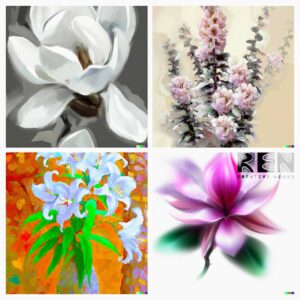
Conclusion: Capturing the Essence of Nature
Floral paintings have captivated artists and viewers for centuries. Their delicate petals, vibrant colours, and intricate details make them ideal subjects for artistic expression. The symbolism associated with different types of flowers adds depth and meaning to these artworks, evoking emotions and stories.
Paintings of flowers can connect us to nature and serenity, enhancing the beauty of our homes and promoting well-being. The enduring allure of floral art lies in its ability to capture the delicate and transient beauty of flowers, creating a sense of timelessness. Floral art continues to evolve and inspire, from traditional styles like Impressionism and Realism to modern interpretations that reflect contemporary concerns.
Renowned artists like Vincent van Gogh, Gustav Klimt, and Claude Monet have made significant contributions to the world of floral art. Their masterpieces showcase the depth of emotion and artistic vision that can be achieved through paintings of flowers.
In a world that is constantly changing, the timeless beauty of paintings of flowers remains a source of inspiration and solace. These artworks resonate with viewers on an emotional level, evoking joy, nostalgia, tranquility, and hope.
Regardless of cultural or generational boundaries, the universal allure of floral art continues to captivate and enchant audiences, reminding us of the enduring beauty that exists in the natural world.
I encourage you to explore the world of floral paintings, admire the creativity that goes into them, and try your hand at making your own masterpieces.
If you enjoyed this article, please show your support by subscribing to my mailing list and sharing it with your network! As an independent artist, your support means the world to me. Your time is valuable, and I appreciate you taking the time to read my work.
Don’t miss out on future articles and updates – subscribe now and stay connected!
Featured Image:
Adrian × DALL·E
Human & AI
DALL·E-2023-10-11-20.41.29—Generate-a-painting-of-flowers-which-captures-a-variety-of-art-movements.-COLLAGE
Adrian Reynolds, or ‘Ren,’ is a Dublin-based contemporary artist. His works are a reaction to the world around us. A world that continues to evolve quicker than ever. His work investigates colour, form, and texture, putting them at the intersection of abstraction and representation. His art has been shown in Ireland, the United Kingdom, and the United States.
Latest Artwork
-
Bullets Travel Distance & Time
Abstract Art Paintings €1,000.00Add to basketBullets Travel Distance & Time | Acrylic Painting By Adrian Reynolds
-
The Perception of Narrative
Abstract Art Paintings €800.00Add to basketThe Perception of Narrative | Fine Art Acrylic Painting By Adrian Reynolds
-
Iridescent Dream
Abstract Art Paintings €240.00Add to basketIridescent Dream | Acrylic Painting By Adrian Reynolds
-
Blue Nebula
Abstract Art Paintings €240.00Add to basketBlue Nebula | Acrylic Painting By Adrian Reynolds
